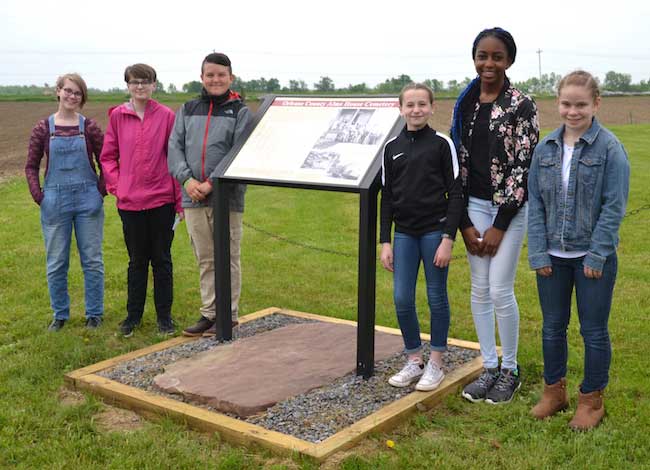Albion students unveil panel that lists people buried in once-forgotten cemetery
‘In today’s world we need to treat people with dignity and respect. We’re giving names to those who were perhaps not treated with dignity and respect.’ – County Historian Matthew Ballard
ALBION – An interpretive panel was unveiled today by Albion seventh-graders and Orleans County officials that lists the names of 250 people buried in a cemetery behind the former Orleans County Alms House on County House Road.
The seventh-grade service learning class at Albion, led by teacher Tim Archer, took the lead with getting the panel erected. The Daughters of the American Revolution contributed $750 towards the panel and the Orleans County Historical Association also donated $500 for the effort. The Orleans County Highway Department installed the panel.
This is the second big effort by Albion students at the site. About a decade ago the former cemetery was overgrown with sumac and weeds. The grave markers were toppled.
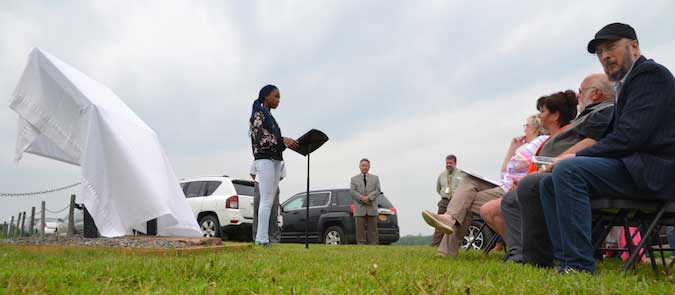
S’Koi Sanders-Smith speaks at the panel unveiling today. Bill Lattin, retired Orleans County historian, is at right.
Bill Lattin was the county historian about a decade ago when Archer’s class first worked on a project at the cemetery. Lattin shared in the class about the name of County House Road, how there used to be an Alms House at the site.
The Alms House opened in 1833 and closed in 1960, when the county infirmary or nursing home opened on Route 31, just west of the Village of Albion.
“The Orleans County Almshouse was the last refuge for old men and women too weak to work and take care of themselves,” Lattin wrote in the foreword of a booklet about the site in 2011. “It became a home for the homeless, friendless, orphan, vagrant, poor, sick, and mentally ill. Dependents, paupers, and even delinquents lived at the Orleans County Home on County House Road.”

Albion students and the county put up this marker for the cemetery in 2011, and also reset grave markers and cleared out brush.
Lattin’s classroom visit about a decade ago spurned Archer and his students to research the site, and work with the county officials to get the site cleaned up, and the stones reset. A historical marker was added by the road, letting people know about the Alms House. After the Alms House building were razed in 1962, the county repurposed the main part of the site for the Civil Defense Center. A fire training tower is next door.
The cemetery is in the back, surrounded by a corn field. When the cemetery was rededicated in 2011, 74 grave markers were reset.
Matt Ballard, the current Orleans County historian, has followed in Lattin’s footsteps as a frequent visitor in Archer’s classes, discussing local history.
Ballard recently made an exciting discovery. He found a ledger from the cemetery, which lists the names and dates of death for 250 people buried at the cemetery. The superintendents of the Alms House kept the ledger, and some of those superintendents added details about the lives of those buried in the cemetery.
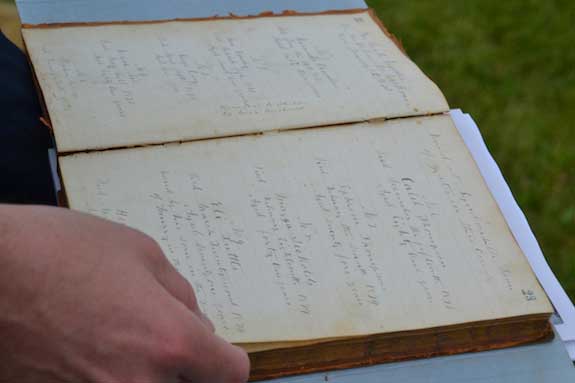
Matt Ballard shows a ledger listing the names and dates of death for people buried at the cemetery. Some of the entries include a biographical sketch of the people who lived at the Alms House.
Ballard said the entries with details of the lives showed compassion and care from the superintendents, who wanted to list some of the contributions of those who were buried often in unmarked graves or with a stone and only a number.
Ballard left the ledger with the class and Archer and his students made a list of all the names and the dates of death. Those details are now on the interpretive panel by the cemetery.
“These are lives worth remembering,” Archer said at a dedication today. “A big part of what I try to emphasize with the kids is that every life has value.”
Ballard praised the school district for supporting a class that does many community service projects and has students “on the front lines working with local history.”
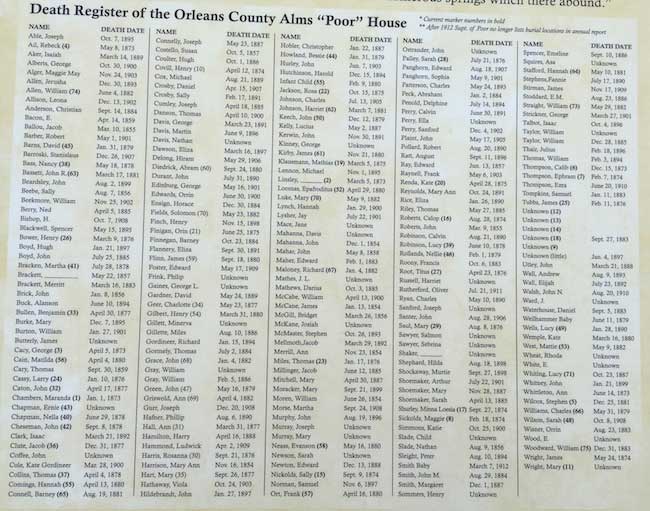
The panel includes the names of people buried at the cemetery. The panel also includes words from Lattin in the foreword of the 2011 booklet: “The names of those who rest here are long forgotten, but their existence deserves respect and reverence. They no longer can speak for themselves. Hence we must note that buried here is someone’s ancestor, a person once loved by those who cherished them in the rocking cradle and held trembling hand in sickness and old age at death’s beckoning. These bodies now dust, are lives worth remembering because of the interdependent web of existence and the inherent worth and dignity of every person.”
The cemetery is now well cared for by the county and is visible from Route 31A near Keeler Construction. Ballard is pleased to see the names of the people are now displayed, rather than a cemetery with only unmarked graves and numbers on stones.
“In today’s world we need to treat people with dignity and respect,” Ballard said. “We’re giving names to those who were perhaps not treated with dignity and respect.”
Lynne Johnson, Orleans County Legislature chairwoman, praised the students and the historians – Lattin and Ballard – for their efforts in honoring the people at the cemetery.
“Today we are here to properly pay tribute to those that are known to be buried in this quaint little cemetery, marked only by numbers but remembered as real people, in the middle of this productive farmer’s field,” Johnson said. “It takes many people to keep history alive.”
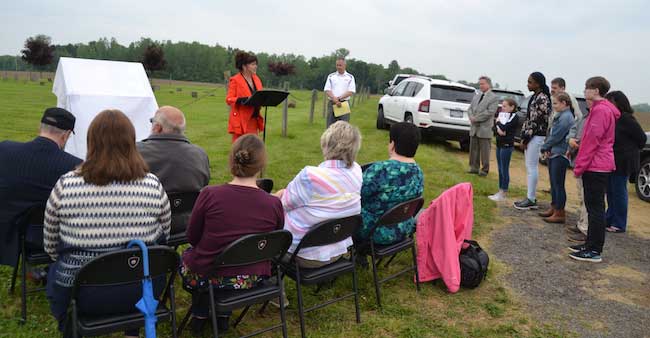
County Legislature Chairwoman Lynne Johnson thanked the Albion students and local historians for their work at the cemetery for the former Orleans County Alms House.
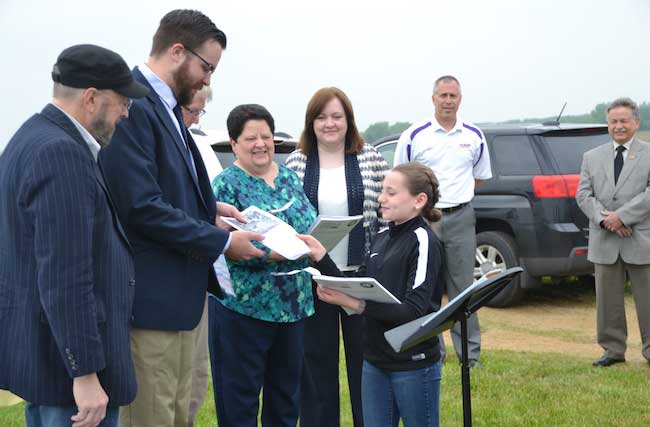
Gina Sidari hands out copies of a booklet about the cemetery that was first published in 2011. It has been updated with the names of people buried at the site. She hands the copies to from left Bill Lattin; Matt Ballard; Betty Sue Miller, director of Hoag Library; Penny Nice, regent of the Orleans County chapter of DAR; Patrice Birner, member of the Orleans DAR and state historian for the DAR; Tim Archer, the service-learning class teacher; and Don Allport, county legislator.





























